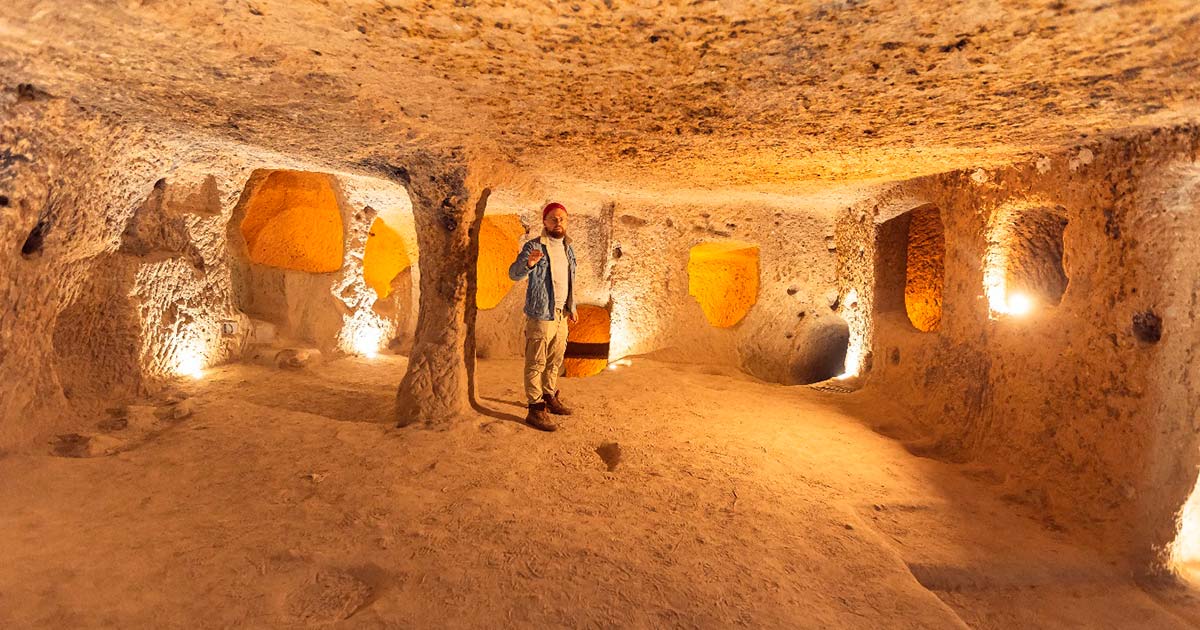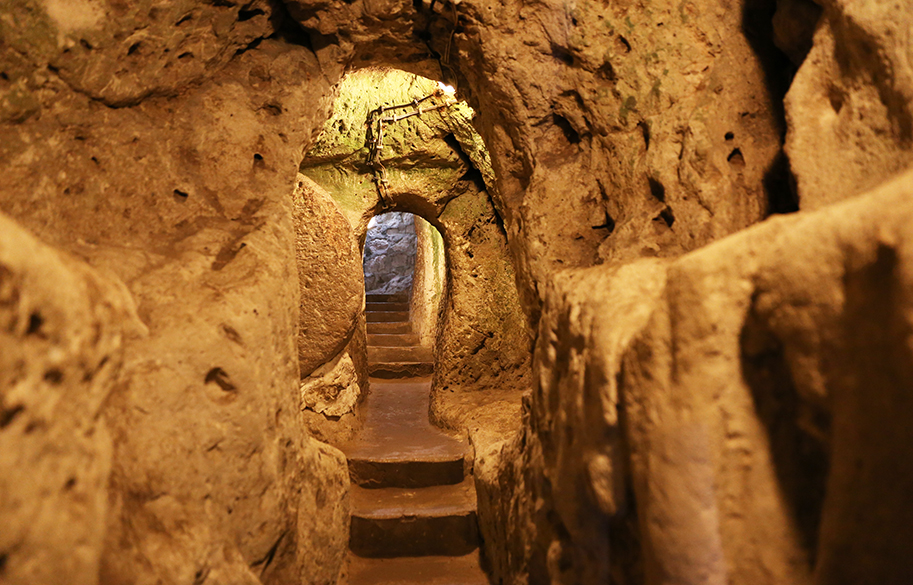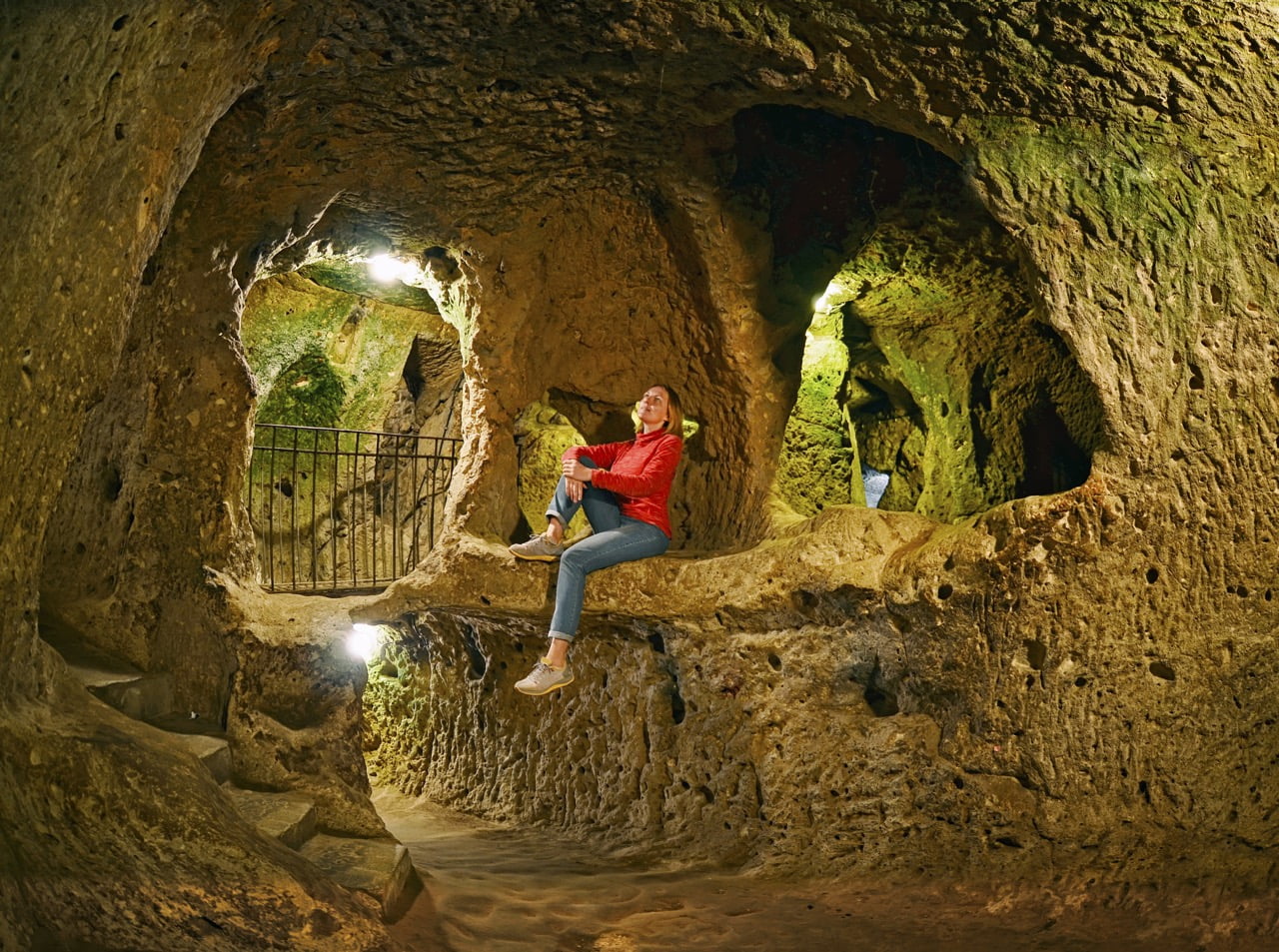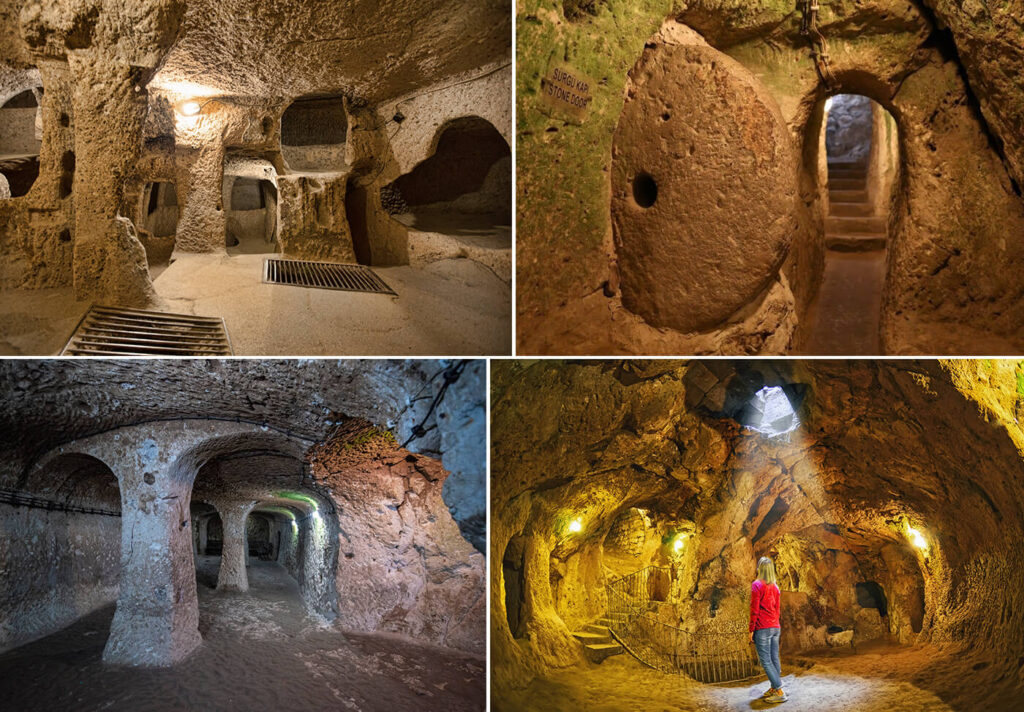Introduction
In the heart of Turkey’s Cappadocia region, a remarkable discovery was made in 1963 that would captivate historians, archaeologists, and curious travelers alike. During a routine home renovation, a Turkish homeowner stumbled upon the entrance to an extraordinary underground city – Derinkuyu. This vast subterranean complex, dating back to around 1200 BC, would go on to reveal layer upon layer of fascinating history, showcasing the ingenuity and resilience of the civilizations that called it home.

Sprawling across 18 levels and capable of housing up to 20,000 people, Derinkuyu stands as a testament to the impressive engineering feats of the ancient world. From its initial construction by the Hittites to its subsequent expansions by the Phrygians and early Christians, this underground haven served as a refuge during tumultuous times, providing shelter, sustenance, and even religious sanctuary to its inhabitants.
In this comprehensive blog post, we’ll delve into the captivating history of Derinkuyu, exploring its origins, its remarkable features, and the pivotal role it played in the lives of those who sought its protection over the centuries. Join us as we uncover the mysteries of this extraordinary ancient underground city.
The Discovery of Derinkuyu
The story of Derinkuyu’s rediscovery began in 1963, when a local Turkish homeowner decided to renovate his home. Little did he know that his simple home improvement project would lead to one of the most significant archaeological finds of the 20th century.

As the homeowner began excavating the foundation of his home, he stumbled upon a mysterious opening in the ground. Intrigued, he investigated further and discovered that the opening led to a vast, interconnected network of tunnels and chambers. This was the entrance to the long-forgotten underground city of Derinkuyu.
News of the discovery quickly spread, and soon, archaeologists and historians from around the world flocked to the site to unravel the mysteries of this incredible find. What they uncovered was a sprawling subterranean complex that had been meticulously constructed and expanded over centuries, serving as a refuge for various civilizations that had inhabited the region.
The Origins of Derinkuyu
The origins of Derinkuyu can be traced back to around 1200 BC, when the Hittite civilization first began to carve out this intricate underground city. The Hittites, a powerful Bronze Age empire that dominated much of Anatolia (modern-day Turkey), were known for their impressive engineering feats, and Derinkuyu was no exception.

The Hittites chose the Cappadocia region as the site for their underground city due to its unique geological features. The area is composed of soft volcanic rock, known as “fairy chimneys,” which allowed the Hittites to easily excavate and construct the complex network of tunnels, chambers, and living spaces that would become Derinkuyu.
As the Hittite Empire declined, the Phrygians, another ancient Anatolian civilization, took control of the region and continued to expand and develop Derinkuyu. They added additional levels, storage facilities, and even religious structures, transforming the underground city into an even more sophisticated and self-sustaining community.
The Expansion and Development of Derinkuyu
Over the centuries, Derinkuyu continued to evolve and grow, with each successive civilization that occupied the region leaving its mark on the underground city.
One of the most significant expansions occurred during the early Christian era, when the city was further developed by early Christian communities seeking refuge from religious persecution. These early Christians added a number of important features to Derinkuyu, including chapels, churches, and living quarters specifically designed for their religious practices.

In addition to these religious structures, the early Christians also expanded Derinkuyu’s capabilities as a self-sustaining community. They constructed stables, wineries, and olive oil production facilities, allowing the city’s inhabitants to be largely self-sufficient and less reliant on the outside world.
The scale and complexity of Derinkuyu’s underground infrastructure is truly astounding. The city is estimated to have been able to accommodate up to 20,000 people, with each level serving a specific purpose, from living quarters and communal areas to storage spaces and livestock pens.
One of the most remarkable features of Derinkuyu is its intricate ventilation system, which allowed fresh air to circulate throughout the underground complex. This engineering feat was crucial for sustaining such a large population in a confined, subterranean environment.
Life in Derinkuyu
Imagine the bustling activity that once filled the halls and chambers of Derinkuyu. As a self-sustaining underground city, it would have been a vibrant and thriving community, with its inhabitants engaged in a wide range of activities and occupations.
The living quarters of Derinkuyu were designed to accommodate families, with each level featuring communal areas, private living spaces, and even small workshops. The early Christian communities that took refuge in the city would have gathered in the chapels and churches, engaging in religious practices and seeking spiritual guidance.

Beyond the residential and religious areas, Derinkuyu boasted an impressive array of facilities that supported the city’s self-sufficiency. The stables, wineries, and olive oil production facilities would have been hives of activity, with skilled artisans and laborers working tirelessly to produce the goods necessary for the city’s survival.
One of the most intriguing aspects of life in Derinkuyu was the city’s defense and security measures. The complex network of tunnels and chambers was designed with strategic considerations in mind, with hidden passageways, ventilation shafts, and even millstones that could be used as defensive weapons.
Derinkuyu’s inhabitants would have lived in constant awareness of the potential for invasion and conflict, and the city’s underground design allowed them to retreat and seek refuge from the outside world whenever necessary. This ability to hunker down and wait out periods of unrest was a crucial factor in the city’s longevity and the survival of its people.
Derinkuyu as a Refuge
Throughout its long history, Derinkuyu served as a vital refuge for the people of the Cappadocia region, providing shelter and protection during times of invasion, conflict, and religious persecution.
The Hittites, Phrygians, and early Christians all sought refuge in Derinkuyu, utilizing the city’s strategic location and formidable underground defenses to safeguard their communities. The city’s vast size and self-sustaining capabilities allowed its inhabitants to withstand prolonged sieges and wait out periods of unrest on the surface.

One of the most significant instances of Derinkuyu serving as a refuge occurred during the Byzantine era, when the city provided shelter to early Christian communities fleeing religious persecution. The underground city’s chapels, churches, and living quarters were adapted to accommodate these refugees, who were able to practice their faith and maintain their way of life while hidden from their oppressors.
Derinkuyu’s role as a refuge was not limited to times of religious or political turmoil. The city also offered a safe haven during natural disasters, such as volcanic eruptions, which were not uncommon in the Cappadocia region. The underground city’s sturdy construction and isolation from the surface provided its inhabitants with a secure and protected environment, allowing them to weather the storms and emerge unscathed.
The Rediscovery and Preservation of Derinkuyu
The rediscovery of Derinkuyu in 1963 was a momentous event that captivated the world and sparked a renewed interest in the ancient underground city. Since then, archaeologists and historians have been working tirelessly to uncover the secrets of this remarkable site and preserve its rich heritage for future generations.
One of the most significant challenges in studying Derinkuyu has been the sheer scale and complexity of the underground city. With 18 levels and a vast network of tunnels and chambers, the task of mapping and documenting the site has been a monumental undertaking. Nonetheless, dedicated teams of researchers have made significant progress, using advanced technologies and meticulous excavation techniques to piece together the story of Derinkuyu.

As the site has become a popular tourist destination, efforts have also been made to ensure its preservation and responsible management. The Turkish government has designated Derinkuyu as a UNESCO World Heritage Site, recognizing its immense historical and cultural significance. Strict regulations and conservation measures have been put in place to protect the site from the impact of increased visitor traffic and to maintain the integrity of its underground structures.
Today, visitors to Derinkuyu can explore a portion of the city that has been opened to the public, marveling at the engineering feats of the ancient civilizations that once called this subterranean haven home. The experience of walking through the dimly lit tunnels and chambers, imagining the bustling activity that once filled these spaces, is truly awe-inspiring and serves as a testament to the ingenuity and resilience of the human spirit.
Conclusion
The discovery of Derinkuyu in 1963 was a pivotal moment in the study of ancient civilizations, shedding light on the remarkable engineering and architectural accomplishments of the Hittites, Phrygians, and early Christians. This vast underground city, with its intricate network of tunnels, chambers, and self-sustaining facilities, stands as a testament to the ingenuity and adaptability of the people who sought refuge within its walls.
As we continue to explore and unravel the mysteries of Derinkuyu, we are left in awe of the remarkable feats of the past and the resilience of the human spirit. This ancient underground city serves as a powerful reminder that even in the face of adversity, humanity has the capacity to create extraordinary and innovative solutions to ensure its survival and prosperity.
Through the preservation and responsible management of Derinkuyu, we can ensure that this remarkable piece of history remains accessible to future generations, inspiring them to explore the wonders of the past and to strive for their own remarkable achievements.

